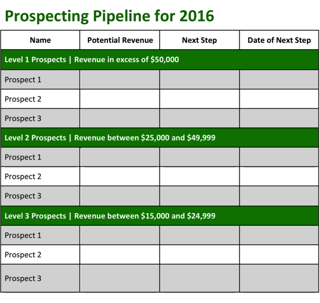Share article
The clock on 2016 is already ticking loudly! As I write this, we are barely a week into the New Year and you’re still catching your breath from a ridiculously busy 4th quarter. However, given a typical sales cycle, you are already a production quarter into the year. It’s probably scary to have to face the reality of how much of 2016 productivity is lost.
I’m going to guess that, largely due to the craziness of 4th quarter, your pipeline of prospects is pretty dry. And, I’m also guessing that you were recently forced to submit, or were given, your new business sales goal for 2016. Regardless of how the new business goal originated, we both know it’s probably a joke. Either you or someone you report to did one of the following:
- Grabbed the same pretend goal from last year
- Added/subtracted some arbitrary % from last year’s goal
- Picked a “round number”, say $100,000
- Or, all too common, didn’t even bother with a production goal at all. I know, ridiculous!!
Just as ridiculous as not setting a goal is not having a plan to make it happen. We recently shared a producer plan, which you can find again here. However, this post isn’t about the plan; it’s about setting a goal in a way that will ensure you reach the highest possible new business number, with fewer accounts and a greater sense of confidence.
This traditional producer sales goal setting is a joke and results in very little confidence - for the producer or the leadership - that it will actually happen. As an example, if your goal is $100,000 and the average revenue of your current accounts is $5,000, it is safe to assume you are going to have to write 20 new accounts to hit your goal.
And, if your pipeline is empty and your sales cycle is 3 months long, you are going to have 9 months to find and write those 20 accounts. Of course, as we just experienced, very little new business happens in 4th quarter, so now you are down to 6 months (26 weeks). You have to write a new account almost every week!
A better way to set your goal
Here’s a simple exercise that will bring clarity to how you can set your own personal goal. When followed, it will almost certainly result in some multiple of new business over your current “pretend goal”; it will become a goal you actually believe in; and it will drastically reduce (likely by half) the number of accounts you need to write.
Get out your pen and paper and let’s start planning. But – I want you to put your current 2016 sale goal out of our mind while we work on this.
Step 1
Given the largest accounts you have written in the past, the resources you have access to through your agency, the market in which you compete, and a general sense of self-confidence, what is the largest account you can see yourself writing this year? While this would be your “sale of the year”, you truly believe you can write an account of this size.
Based on the feedback I get when asking this question of those with whom we coach, I’m going to use a conservative example of $50,000 as the “sale of the year.” Of course, your's may be larger.
Step 2
Take that same line of thinking down to a quarterly level. What size account do you feel confident that, given the right number of opportunities, you could write on a quarterly basis?
Based on those with whom we coach, I’m going to use $25,000 as the “sale of the quarter” example.
Step 3
Taking the thinking down one more level, what size account do you feel confident you could write a half dozen of in 2016?
A conservative answer I am typically given would be $15,000.
 Now, add up all of your answers.
Now, add up all of your answers.
(1) $50,000 account = $50,000 of new business
(4) $25,000 accounts = $100,000 of new business
(6) $15,000 accounts = $75,000 of new business
TOTAL new business goal based on this exercise? $225,000
TOTAL number of accounts to hit the goal? 11
Look back at your own answers. Is there anything you wrote down that you don’t feel is possible? Now, I didn’t say EASY, I said POSSIBLE. Of course, this is going to take much more intentional prospecting and a much more focused effort in general, but, I ask you (with more than a hint of sarcasm), would the results be worth it?
I challenge you to break your pipeline down into these three levels and track your prospects in a tiered fashion rather than a “thrown all together” fashion. As basic as it likely seems, a tiered pipeline brings a new level of clarity and purpose that leads to much more intentional and effective prospecting. Maybe even more important than what this pipeline focuses on is what it doesn’t include: those “too small” accounts you really shouldn’t be writing anyway.
Successful new business years don’t just happen, at least not anymore. Nobody is responsible for your success more than you; push aside your pretend goal and focus on something that gets you freakin’ fired up!!
Now, go make it happen!!
Content originally published on Q4intelligence
Photo by Andrewgenn
